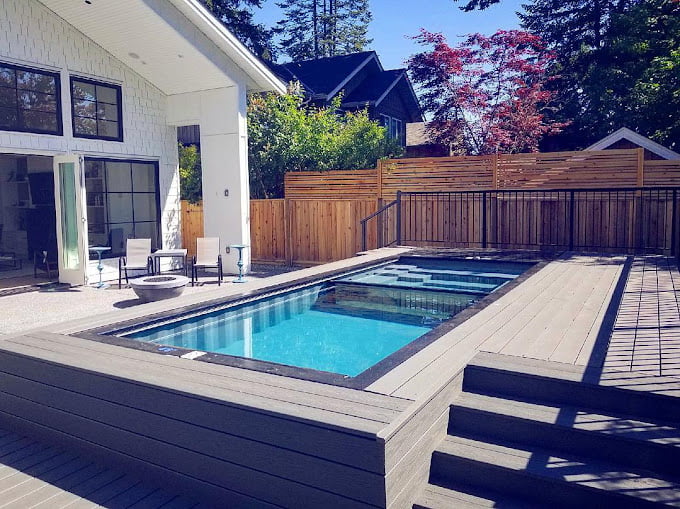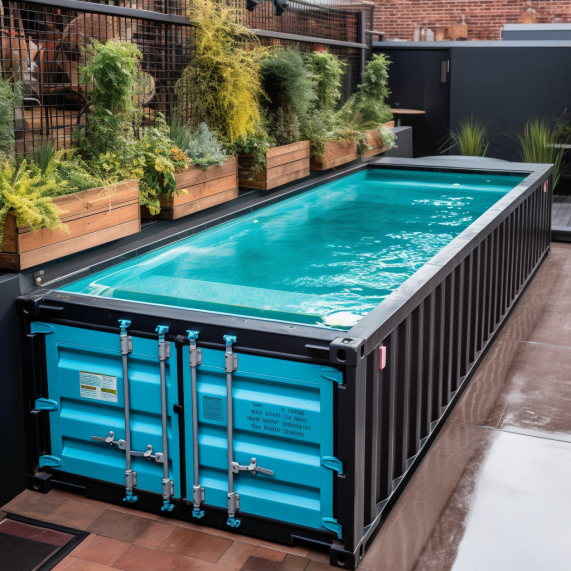Welcome to our deep dive into the exciting world of shipping container pools! This latest trend in backyard fun is heating up, and we’re here to tell you why. These unique pools offer a sustainable alternative to traditional in-ground pools, redefining how we cool off during hot summers.
Our focus in this article? The environmental impact. Traditional pools may seem harmless, but their environmental footprint is sizeable. We’re going to contrast this with the surprisingly green alternative of shipping container pools.
We’ll also be exploring the many benefits of these pools, as well as a few challenges. Along the way, we’ll visit some real-life examples of these transformative pools in action. By the end, we hope to shed light on why shipping container pools are a game-changer for both swimming and sustainability.
Table of Contents
ToggleWhat is a Shipping Container Pool?

First, let’s define what we’re talking about. A shipping container pool, as the name implies, is a swimming pool created from a repurposed shipping container. Typically, these are 20 or 40 feet in length, but can be customized to different sizes.
The concept isn’t very old. In the last decade, innovative companies started turning old containers into modern, stylish pools. Their popularity has soared recently.
Why the excitement? One reason is the unique, industrial aesthetic. But it’s not just about looks. Shipping container pools are also fast to install, flexible in design, and often cheaper than traditional in-ground pools.
Stay tuned, as we delve into the environmental implications of this rising trend in the next section.
The Environmental Impact of Traditional Pools

Traditional pools can leave quite an environmental footprint. Firstly, they require a large amount of concrete for construction. It’s important to note that concrete production is a significant source of global carbon emissions.
In addition to construction materials, energy consumption becomes another concern. Heating, filtration systems, and lighting all use substantial amounts of energy.
And let’s not forget water. Pools require enormous quantities of it, not just for initial filling, but also to replace water lost through evaporation.
Lastly, maintaining the pool’s cleanliness often involves using a variety of chemicals. These substances can be harmful to the environment when they find their way into our natural water sources.
Contrast this with shipping container pools, as we will in our next section, and you’ll see why they are causing a splash in the pool industry.
The Environmental Benefits of Shipping Container Pools

Shipping container pools stand out as a green alternative for several reasons. Firstly, they repurpose used containers, helping to reduce waste. It’s a great example of upcycling at its finest.
These pools also require less construction material overall, reducing their carbon footprint. Moreover, they minimize the need for concrete, a major source of CO2 emissions.
Energy efficiency is another benefit. Many models incorporate insulation that helps maintain the water’s temperature. Consequently, they consume less energy for heating.
In terms of water usage, they typically hold less water than traditional in-ground pools. That translates into less water for filling and topping up.
Lastly, shipping container pools are built to last. Their robust construction means less need for replacement, thus further reducing their environmental impact.
Still, they are not without challenges, as we’ll discuss in the upcoming section.”
Case Studies: Real-life Examples of Shipping Container Pools

Let’s look at real-world examples to illustrate the benefits we’ve discussed. Firstly, consider ‘Pool Box’. This company based in Canada specializes in converting shipping containers into pools. They report saving hundreds of pounds of concrete and reducing CO2 emissions significantly with each pool they install.
Next, we head to Australia. ‘Container Pools’ has made waves by designing models that use high-grade insulation. As a result, they claim to reduce the energy required for heating by up to 40%.
Finally, there’s ‘Modpools‘, another Canadian firm. They have developed a unique filtration system that reduces the need for chemicals. They also include a removable divider that transforms part of the pool into a hot tub, further maximizing usage.
These cases highlight the potential for shipping container pools to be both environmentally friendly and innovative.
Potential Drawbacks and How to Mitigate Them
While shipping container pools have many benefits, they also have a few potential drawbacks. Let’s explore these issues and discuss how to mitigate them.
Firstly, shipping containers are usually narrow. This can limit their use for activities such as lap swimming. However, custom designs and pool orientation can help maximize usable space.
Secondly, containers often require modification for safety and comfort. Sharp edges need smoothing, and insulation is necessary for temperature control. Fortunately, professional conversion companies address these concerns as part of their service.
Lastly, used containers can have wear and tear or damage that needs repair. Thus, it’s crucial to select a high-quality container for conversion. Look for providers who thoroughly inspect and prepare containers for their new life as a pool.
Despite these potential challenges, with careful planning and professional assistance, a shipping container can become a delightful and eco-friendly swimming pool.
Future Developments in Shipping Container Pools
As this trend continues to grow, the industry is evolving. Innovations are enhancing the appeal and eco-friendliness of shipping container pools. At Blue Box we lead the pack when it comes to innovation
One promising development is the integration of solar heating. This will further reduce the energy footprint of these pools. Companies are exploring solar technology to efficiently heat pool water.
Another trend is the increasing use of natural filtration systems. This reduces reliance on chemical disinfectants. These systems use plants and microorganisms to keep the pool water clean.
On the horizon, we also see developments in smart pool technology. This includes energy-saving features like automated pool covers and smart lighting. These advances promise to make shipping container pools even more sustainable.
In conclusion, the future of shipping container pools looks bright, with the potential to be greener than ever.
Conclusion
In the face of rising global temperatures, the appeal of having a backyard pool is undeniable. Yet, the environmental cost of traditional pools cannot be overlooked. This is where shipping container pools come into play.
By repurposing used containers, these pools promote sustainability. Their smaller size and efficient design reduce both water and energy usage. Coupled with the ongoing innovations in the field, these pools are set to become even more eco-friendly.
While there are potential drawbacks, they can be mitigated with careful planning and professional help. Therefore, if you’re considering a pool, a shipping container might just be the green and trendy option you’re looking for.
As we look towards the future, the tide seems to be turning in favor of these sustainable alternatives. Truly, shipping container pools are making waves in more ways than one.

